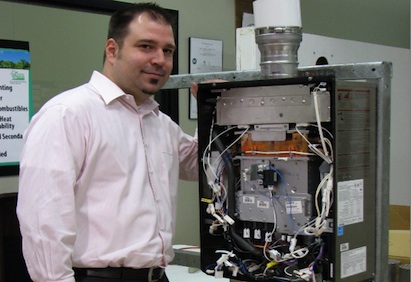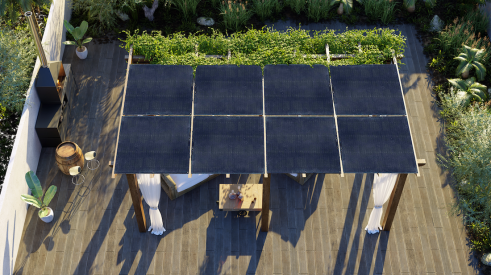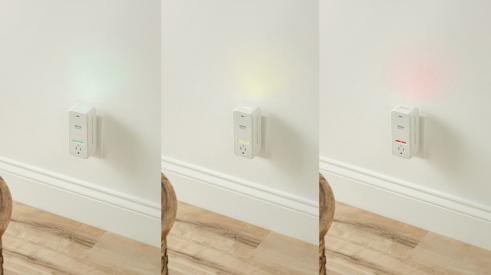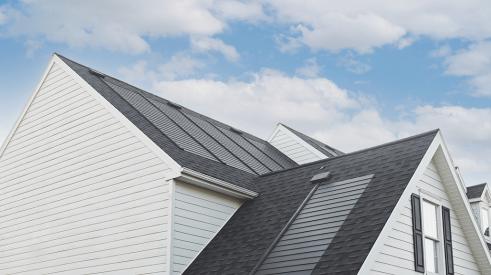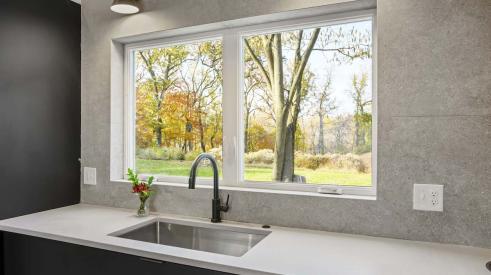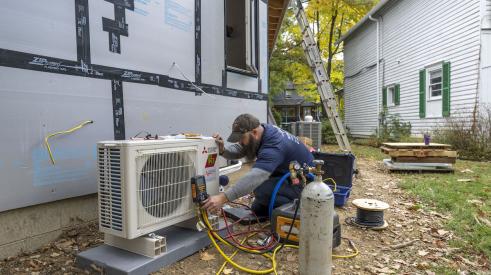Greater energy savings have played an important, but still secondary role in the rising profile of condensing tankless water heaters, which offer efficiency gains of approximately 10 to 15 percentage points over conventional units: from percentages in the low to mid 80s to around 95 percent. Like their conventional counterparts, all condensing units carry the Energy Star label. But as impressive as these energy savings are, ease of installation remains the main growth driver for this technology.
Condensing tankless water heaters use a secondary heat exchanger to boost efficiency by capturing more heat from combustion gases as they escape up the flue. This heat-absorption process, in turn, cools these gases enough to permit venting with less costly, more installer-friendly PVC piping, rather than Category III Stainless Steel.
PVC venting makes tankless far more attractive for first-time installers, many of whom have never used Category III Stainless Steel. When I tell attendees at my workshops that they can use PVC, their eyes light up. Virtually every service tech knows PVC inside and out. What’s more, the material requires zero clearance to combustibles. All of which is why, as more and more homeowners request a tankless replacement for their tank-type water heaters, the path of least resistance will be to go condensing tankless to vent with PVC.
Tankless technology has been the preferred method of heating water for domestic use for decades in numerous countries worldwide. Condensing technology hasn’t been around for as long, but it has proven itself equally reliable in numerous applications, residential and commercial.
How much more does a condensing tankless water heater cost versus a conventional tankless unit?
The numbers vary by locale, but on average installing contractors can expect to pay 30 to 40 percent more. However, the additional cost to your customer may be in the range of only 15 to 20 percent per installation. Why? Because you will be using PVC venting at $1.53 per foot right now versus $25 per foot for Category III Stainless Steel.
How much more energy will condensing tankless water heaters save over their conventional counterparts?
The efficiency gain is about 10 to 15 percentage points, maxing out at around 95 percent. That is not as dramatic an improvement as switching from tank to tankless, but it is not insignificant over the estimated 20-year life of the water heater.
Is condensing tankless technology better suited to certain sections of the country?
The technology will work equally well everywhere, regardless of weather conditions. But the fact is, in warmer climates, tankless water heaters are often mounted outdoors, eliminating the need for venting. In these cases, the PVC venting advantage is not relevant. If the end user or homeowner is not interested in the additional efficiency, the less-expensive conventional tankless will be the likely choice. After all, tankless is still much more efficient than a traditional tank-type water heater, not to mention all of the space savings because of its wall-mount capability.
All of which is why condensing tankless water heaters are more popular in the Midwest and the Northeast as well as Canada where water heaters must be installed indoors and the PVC venting advantage is critical.
How does a condensing tankless water heater work?
Like any tankless water heater, it is an on-demand system with no hot-water storage and no pilot light burning 24/7. When a hot-water appliance, faucet or fixture is turned on, the tankless system senses flow and a spark igniter activates the gas burner. As cold water enters the system, the heat exchanger rapidly raises the temperature of the flow to the designated set point before the water proceeds to its destination. However long the fixture or appliance operates, the tankless unit will meet the demand for water at the set temperature; i.e., “endless hot water.”
A condensing unit uses the same sequence of steps to generate hot water, but also incorporates a secondary heat exchanger to capture more heat from the combustion gases before they enter the venting at the top of the flue. This secondary heat exchanger then preheats the incoming water on its way to the primary heat exchanger, increasing the unit’s efficiency.
How much heat does the secondary exchanger absorb?
In a conventional tankless unit, the gas temperature at the top of the flue is between 330°F and 360°F. In a condensing unit, the secondary heat exchanger will lower this temperature to around 105°F to 130°F — a major difference without sacrificing hot-water output or water pressure. This reduction is why venting with PVC is permitted.
What happens to the condensate?
The process of reducing combustion-gas temperatures necessarily creates condensate in the flue: an acid-water mixture that drips back into the water heater and through the secondary heat exchanger. If that device is made of aluminum or copper, the unit will likely corrode over time, undermining both performance and longevity. A secondary heat exchanger made entirely of
stainless steel will not have this corrosion problem, extending the life of the water heater, albeit at a higher unit cost.
Is condensing tankless any more difficult to install than a conventional model?
No, and with PVC venting, installation should go more quickly and easily. The installer can build the vent run using four-inch PVC throughout. Or, if the termination point in the wall is three inches and the homeowner does not wish to enlarge it, the installer can reduce the run to that smaller size.
The biggest installation difference is the need to install a condensate line, but this requirement should not add much time or cost to the installation. A condensing tankless model typically has a half-inch port at its base. Following local codes, the installer simply runs a pipe from this port to a nearby drain.
Finally, a condensing tankless unit will be slightly larger than a conventional unit with comparable specifications — but not by much. The larger dimensions should not impact handling on the job site, nor will they lessen the inherent space-savings advantage of tankless.
Will a condensing tankless water heater require a larger gas line?
That is a possibility. The typical gas storage water heater offers inputs of 40,000 to 50,000 BTU, while the most popular condensing units are modulating devices that max out at 199,000 BTU. So the installer must be aware of the possible need to upsize the gas line from half-inch to three-quarter inch. That shouldn’t be a negative, because the size of the gas main coming into a dwelling is usually three-quarter inch as well.
How does a contractor sell the homeowner on using condensing tankless?
The more difficult selling job will likely be switching the customer from tank to tankless. As I tell contractors who attend my training sessions: The first question to ask a homeowner customer is, “Have you ever run out of hot water?” If the answer is “Yes,” you have probably a better than 50 percent chance of persuading him or her to make the switch. Anyone who has suffered through a cold-water shower never wants to experience that misery again, and tankless provides that reassurance.
Once the contractor has persuaded the consumer to switch, selling up to a condensing tankless solution should not be difficult. As I noted earlier, using PVC venting lowers installation time and expense, helping to defray the extra cost of a condensing unit. Consumers will happily welcome anything that gets the installer off the job — and life back to normal — more quickly.
How does the remodeler benefit by offering condensing tankless?
Condensing technology represents the elite end of the tankless water-heating segment, offering superior energy efficiency for a relatively modest up-charge. This technology can truly help separate remodelers from their competition.
Tankless, in general, can also add value to the home. Basements and other utility areas can be turned into active living spaces, because homeowners no longer need to worry that the water heaters will malfunction, spilling 40 or 50 gallons of water and ruining floors and furnishings.
Jason Corey, a five-year veteran of the tankless water heating business, serves as Midwest branch manager for Noritz America. He can be reached at jcorey@noritz.com.
The popularity of condensing technology in tankless water heaters has risen steadily in recent years despite the worst construction market in memory.
Add new comment
Related Stories
Working Toward Affordable, Resilient Homes
A new natural disaster protection act from NAHB aims to support hazard mitigation projects
Client Design Choices in the Time of Social Media and AI
Social media speeds up the trend cycles, and now artificially created images are falling into homeowners' hands
Indoor Air Quality Gets Smart
A home's air quality can now be cloud connected and fully automated with this innovative product
Webinar: From Disjointed Design to Cohesive and Efficient—The New American Remodel 2023
Access the recording for the first The New American Remodel webinar held on March 8 at 2 pm CT
5 Standout Energy-Efficient Products Spotted at IBS 2023
See what this green remodeler recommends from the show floor
Innovative Products: GAF Energy Timberline Solar Shingles
GAF Energy’s latest innovation has taken the solar world by storm
Detailed Design: Benefits of Biophilism
See the details our Model ReModel contractors chose to infuse nature into their ADU
Heat Pumps Now Required in Washington New Construction
Washington is the second state to require heat pumps in an effort to electrify homes



